The X Button
Future Events
by Todd Ciolek,

Folks, the first major game of 2012 is here. Abobo's Big Adventure is up and running.
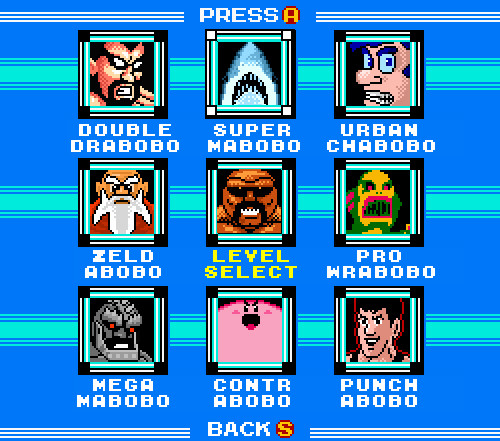
It's technically about the big guy from Double Dragon, but it's really about the entire culture that Nintendo built with its 8-bit game console in the late 1980s. Abobo swims through an underwater Super Mario Bros. stage, scours a Zelda dungeon, fights through the toughest Mega Man 2 level, and discovers countless pieces of NES history. It mixes original sprites with graphics straight from the games, creating something that probably isn't covered under fair use laws. But that's OK, because it's all in good fun. Well, most of it is. Some of it relies on the empty, violent humor that fills too many Newgrounds creations. For example, the water level brings Abobo face to face with the mermaid from The Goonies II, and his options are as follows: Eat, Hit, Mate, and Vomit. Only one of those choices brings remotely funny results.
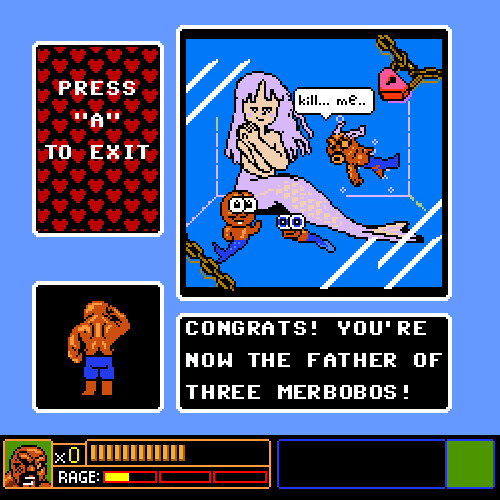
Even if Abobo's Big Adventure goes for cheap and blood-drenched laughs too often, it's still an enjoyable game that ably replicates the feel of NES highlights. Perhaps we're all too easily sold on the nostalgia of an era where people “played Nintendo,” but I think there's still room for affectionate and competent tributes like this. And there's also room for a sequel. I didn't see any stages based on The Guardian Legend or Vice: Project Doom this time around.
NEWS
HUDSON SOFT DISAPPEARS IN MARCH, AND I AM SAD
Many lamented the closing of Hudson Soft's American branch in 2011, but they also took solace that the Japanese parent company was still around. It endured as part of Konami, much like Taito endures as part of the Square Enix empire. Well, even the puppet-state Hudson's days are numbered. On March 1, Hudson ceases to be Hudson. All of its games and characters (and, one hopes, a good chunk of its staff) move over to Konami, and the Hudson logo and Bee will now have "a member of Konami Group" underneath them. Konami will almost certainly keep up the steady pace of Bomberman games, but other Hudson staples aren't as secure. Adventure Island, Bloody Roar, Tengai Makyo, Bonk, and lesser Hudson franchises might be shelved or turned over to the unglamorous realm of cell-phone software. Is this an end befitting a company that's made games since 1978? A company that turned Takahashi “Master Higgins” Meijin into a game-industry celebrity because he could fire 16 shots a second in Star Soldier? A company that brought Princess Tomato in the Salad Kingdom to the children of North America?
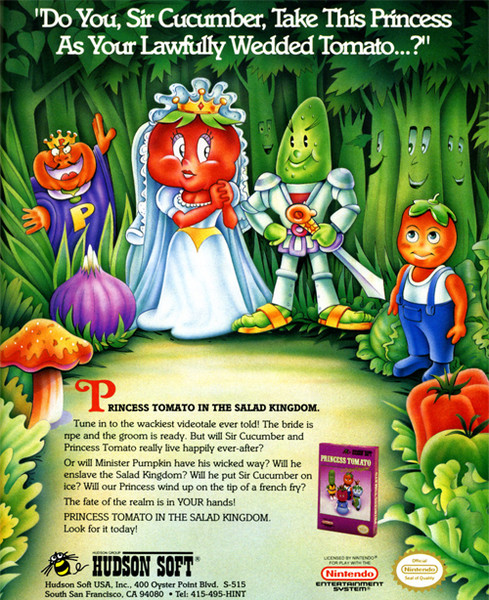
No, it isn't. Hudson Soft has only a month or so left, and they need a memorable exit. Let them not drift quietly into history like Henry Hudson, abandoned in a distant land by his own crew. No, Hudson Soft should be inspired by Hudson from Aliens, spewing bullets and profanity to the bitter end. Not that I endorse actual gunfire. An illustration of Master Higgins pummeling the Konami logo would be more appropriate.
STREET FIGHTER X TEKKEN UNVEILS LATEST, POSSIBLY LAST CHARACTERS
Capcom dragged out the roster revelations for Street Fighter X Tekken so much that I didn't bother reporting on each and every one of them, but they're apparently in the final stretch. The game's out the first week of March, and there isn't much space left on the website's character page. And now there are six more faces to add: Juri, Balrog, and Vega were drafted from Street Fighter, while Tekken contributes Paul Phoenix, Law, and Xiaoyu.
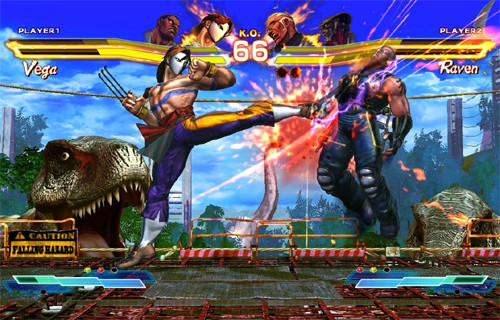
For those keeping track, the new additions join Ken, Ryu, Ibuki, Zangief, Guile, Abel, Rufus, Chun-Li, Sagat, Cammy, Rolento, Poison, Hugo, Dhalsim, and M. Bison in the Street Fighter half of the lineup. The Tekken half has Nina, Steve Fox, Kazuya, Hwoarang, Julia Chang, Kuma, Yoshimitsu, Raven, Asuka, Lili, Bob, Heihachi, Marduk, King, and Jin. And if you're buying the PlayStation 3 or Vita versions, Infamous' Cole and Sony mascots Kuro and Toro are also included (plus Pac-Man in the Vita edition). While that's a substantial selection, it's also heavy on characters who've already shown up in Street Fighter or Tekken. A shameless crossover it may be, but Street Fighter X Tekken is still a great opportunity to bring back lesser-known fighters or introduce new ones. Sadly, Poison and Rolento are the only unexpected names so far. An alleged roster leak put Karin, Sodom, and the worst Street Fighter character (that'd be Rainbow Mika) in the game, so perhaps producer Yoshinori Ono is saving some surprises for the month before the game hits. He's just the type to do that.
SPIRIT CAMERA ISN'T FATAL FRAME 4, BUT IT'S COMING TO NORTH AMERICA
Are you still mad that Nintendo of America never brought Fatal Frame 4 to the North American Wii? That's OK. A lot of people are. And while all hope is lost for that particular game, there's something similar in Spirit Camera: The Cursed Memoir, a 3DS spin-off of Tecmo's Fatal Frame series. It's coming to North America this April 13, courtesy of Nintendo itself.
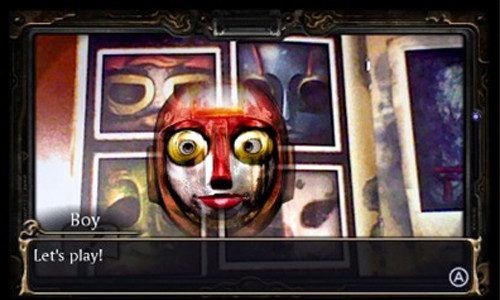
Like the Fatal Frame series, Spirit Camera leans heavily on the atmosphere common to modern Japanese horror flicks like The Ring and Ju-On (both of which had video game adaptations released here). The game equips players with a camera and sends them into a haunted house, and photography is the most reliable weapon in fending off the home's resident ghosts and rescuing a girl trapped there. Most interesting is the 16-page AR book included with the game. Using the same technology as Nintendo's AR cards, the book displays images through the 3DS camera, spawning all sorts of graphic surprises.
IN BRIEF: A BLACK LAGOON GAME, A KID ICARUS STAND, A MAY MERURU MEETING
I've often felt that Rei Hiroe's Black Lagoon would make a pretty good video game, and apparently HMV Japan thought the same…in theory. In practice, their Black Lagoon game will appear on the PlayStation Vita as the fifth installment of Slotter Mania, a pachislot series. That means it'll be full of simulated pachinko and slot machine play, though I can at least hope all of its animated effects involve swearing, shooting, and extremely drawn-out story arcs about South American revolutionaries who turn high-class maids.
Does Nintendo know something unflattering about Kid Icarus Uprising? The 3DS game comes with a system-steadying stand when it arrives on March 23, and some wonder if the game is difficult to play when holding the 3DS normally. I would dispute this, since Uprising didn't seem hard to handle when I tried it at Comic-Con. I doubt any longtime Kid Icarus fans will be dissuaded by this, since they've waited 20 years for another Kid Icarus game. And I'm not about to refuse a free stand.
NIS America wastes little time in catching up with Gust's Atelier series. The latest in line, Atelier Meruru: The Apprentice of Arland, arrives in North America and Europe this May. That's less than a year after its Japanese launch, and only eight months after its predecessor, Atelier Totori, arrived in the U.S. It's hard to say how Tecmo Koei's purchase of Gust will affect localized Atelier games , but it sure isn't slowing NISA down right now.
SPECIAL FEATURE: 2012 PREDICTIONS
It's time to take a long, studied look at the future. It's also time to ignore everything that doesn't concern video games. I refuse to play into the prevalent doomsaying about Mayan prophecies and all that, but when it comes to the game industry, I'll say all the doom I can.
THE LAST STORY COMES TO AMERICA, PANDORA'S TOWER DOESN'T
Of all the fan-driven controversies that sprang up last year, Operation Rainfall mattered the most. A number of Wii owners were distraught when Nintendo of America didn't follow Nintendo of Europe in releasing Xenoblade Chronicles, The Last Story, and Pandora's Tower. So a good chunk of those Wii owners formed Operation Rainfall, an online group dedicated to pelting Nintendo with requests for all three games to come to North America. In a shocking display, they got what they wanted. Late in 2011, Nintendo of America announced a limited release for Xenoblade Chronicles.

Where does this leave the other two games? Well, The Last Story seems likely to follow suit, as long as Xenoblade isn't a colossal failure. Xenoblade earned many accolades from the press, but The Last Story is the latest game from Final Fantasy creator Hironobu Sakaguchi. The mere presence of the FF-words gives The Last Story a weight that Xenoblade didn't have, and so it would be no stretch to see Nintendo greenlighting a North American version of The Last Story, especially when Nintendo of Europe's already localized it. The odds are less favorable for Pandora's Tower, an action game from the largely unknown developer Ganbarion. It has a lower profile than the other two games, and any American release would show up close to the launch of the Wii U. Plus, I want a U.S. version of Pandora's Tower the most, and that means I probably won't get one.
Counterpoint: Xenoblade Chronicles will be available only from Nintendo's site and GameStop in North America, which doesn't suggest a lot of faith in the game. It's much more likely that Nintendo will toss out limited supplies of Xenoblade and use its modest-at-best sales as an excuse to pass on The Last Story or Pandora's Tower in the U.S.
THE FIGHTING GAME WAVE BREAKS
Here's a brief recap of the fighting games coming this year: Street Fighter X Tekken, Tekken Tag Tournament 2, Soul Calibur V, Persona 4: The Ultimate in Mayonaka Arena, BlazBlue: Continuum Shift Extend, Skullgirls, Phantom Breaker, Virtua Fighter 5 Final Showdown, and possibly Sega's Chaos Code. Spurred by Street Fighter IV, fighting games are enjoying a boost well beyond their usual competitive circles and cult followings. It's not exactly the Great Fighter Panic of the 1990s, but the genre might be headed for a similar crash.

Why? Because it's too much too soon. The first fighter craze fell apart due to a glutted market where publishers pushed frequent and minimally improved sequels and upgrades, with Capcom's Super Street Fighter II Turbo perfectly embodying the era's hubris. Much the same thing has happened this generation: Street Fighter IV saw two sequels, The King of Fighters XII was a weak preview of The King of Fighters XIII, and Capcom and Namco are planning both Street Fighter X Tekken AND Tekken X Street Fighter. And the public's starting to get sick of it. Devoted fans have already complained about Street Fighter X Tekken's gem system, and most of them don't trust Capcom's claims that the game won't have a pricey upgrade. It's all reminiscent of 1995.
Counterpoint: Fighter enthusiasts are a devoted bunch. Yes, they complain about upgrades, but they buy them all the same. And fighting games never fell all that far. They were an essential part of the game industry even after Street Fighter and Mortal Kombat cooled off, and they'll be going strong for a while now.
THE VITA IS A MODEST SUCCESS, THE WII U IS A SLOW STARTER
Sony's new handheld didn't fare well in Japan this past December, where sales dropped so low after the launch week that it was outsold by the PSP—the system it is, in fact, replacing. So there's some worry over how the Vita's American launch will go. It'll likely be smoother. Some impressive third-party titles are on the way, and Sony has yet to fire off Gravity Rush and other games that really exploit the handheld's motion sensor and two touchscreens.
The Wii U, meanwhile, probably won't be an instant smash upon its debut late this year. While the controller's built-in touchscreen is novel, the console itself seems too much an expansion of the Wii. Even the name implies an upgrade rather than a new system, and the parents and mainstream buyers who picked up Wiis might not see enough improvement. The “core” crowd that Nintendo hopes to please will be too busy demanding translated Wii RPGs like The Last Story and Earth Seeker to embrace a new system.
Counterpoint: The Vita will struggle for the same reason the 3DS struggled: handheld systems are rapidly being usurped by smartphones. The Vita competes as much with the iPhone and Droid as it does with Nintendo's 3DS, and that's a far more crowded playing field. As for the Wii U, it'll go up against iPads and other tablets, but it won't face any new systems. Microsoft and Sony won't have fresh consoles out by the time the Wii U hits, and that'll give Nintendo a big opening.
THE DIVIDE GROWS
The game industry is losing its middle ground. When Hudson Soft's American branch closed last year, former employee Morgan Haro observed that companies are “either a hit, or an indie developer looking to be a hit.” Hudson's Japanese branch will be absorbed by Konami at the beginning of March (see above), and other developers have already vanished entirely. Indeed, the last two years saw the demise of smaller studios with real potential. Cavia was dissolved by AQ Interactive shortly after making their first truly good game with Nier. Game Republic crafted some intriguing cooperative gameplay with Majin and The Forsaken Kingdom (and to a far lesser extent, Knights' Contract) before shutting down. Ninja Studio, whose Izuna games shaped up to be solid dungeon hacks, quietly vanished.

This leaves an industry driven by big-budget titles from big-budget publishers, and it's a dangerous place for companies that are too large to be indie and too small for the big leagues. This gap is especially dangerous for publishers of niche Japanese titles, including NIS America, XSEED Games, and Aksys Games. Atlus has arguably found their forte, but what about the other localizers—or the studios that make the games in the first place? As the Japanese game industry contracts and retreats into handheld titles and safe bets, more and more studios will fight over a smaller piece of the pie.
Counterpoint: What else is new? The game industry has always been cruel to companies that couldn't evolve with the times or strike the right allegiances. It may be tragic to watch Hudson shackled, but there's no question that other developers had their chances. Cavia and Game Republic turned out many mediocre games before improving, and Ninja Studio couldn't compete with the dungeon hacks of Etrian Odyssey and 7th Dragon.
NEXT WEEK'S RELEASE
FORTUNE SUMMONERS: SECRET OF THE ELEMENTAL STONE  Developer: Lizsoft
Developer: Lizsoft Publisher: Carpe Fulgur Platform: PC (Steam/Gamersgate) Players: 1 MSRP: Under $20 There's a demo? Yeah, right here. Like many games from Japan's underground, Lizsoft's Fortune Summoners preserves a vital species. In this case, it's the side-scrolling, multi-character action-RPG. The fairly recent Trine 2 was the same sort of effort, but the hand-drawn art of Fortune Summoners puts it closer to such ancient Falcom treasures as Legacy of the Wizard, Sorcerian, and Popful Mail. Being a modern creation, though, Fortune Summoners is much more aggressive in its cuteness. It finds sword-fighter Arche, sorceress Stella, and healer Sana trekking through caves, ruins, and whatever other monster-filled hazards the countryside of Scotsholm can conjure. True to the game's distant inspirations, players can switch between the three girls at any time (once they're all recruited), and each adventurer has her own useful abilities. Fortune Summoners doesn't mix genres like Carpe Fulgur's most popular localization, the merchant-themed dungeon hack Recettear. Instead, it's all about jumping, attacking, and, most importantly, timing it all just right. Arche's swordfighting doesn't reward mindless button-pounding, and it's equally important to manage the mindsets of the two computer-controlled allies following the lead. The game also looks rather detailed its characters and backgrounds, though the accompanying artwork shows the generic, blushing face of modern anime-game aesthetics. Hey, Carpe's past releases overcame that same initial impression.
|
discuss this in the forum (19 posts) |
this article has been modified since it was originally posted; see change history